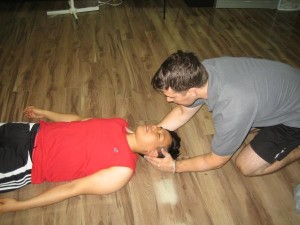In neurogenic shock, vasodilatation occurs as a result of a loss of balance between the parasympathetic and sympathetic stimulation of the nervous system. Sympathetic stimulation causes vascular smooth muscles to constrict and parasympathetic stimulation causes the vascular smooth muscles to relax or dilate.
The individual who experiences neurogenic shock experiences a predominant parasympathetic stimulation that causes dysfunctional vasodilatation lasting for an extended period, leading to a relative hypovolemic state. However, blood volume is still adequate, since the vasculature is still intact due to the fact the that blood volume in this case is simply displaced which results in a hypotensive state (lowering of blood pressure). The overriding parasympathetic stimulation that occurs with neurogenic shock causes a drastic decrease in the patient’s systemic vascular resistance and bradycardia. Inadequate BP results in the insufficient perfusion of tissues and cells which is common in all classifications of shock.
Causes of Neurogenic Shock
Neurogenic shock can be caused by spinal cord injury, spinal anesthesia, or nervous system damage. It may also result from the depressant action of medications or from a prolonged insufficiency of glucose (insulin reaction to shock). Neurogenic shock may have a prolong course such as in cases of spinal cord injuries or a short one as in the case of fainting. Usually, during states of stress, the sympathetic stimulation causes the BP and heart rate to increase.
In neurogenic shock, the sympathetic system is not able to respond to body stressors. Therefore, the clinical characteristics of neurogenic shock are basically signs of parasympathetic stimulation. It is characterized by dry war skin rather than the cool, moist skin seen in hypovolemic shock. Another special characteristic is hypotension with decreased heart rate (bradycardia) which is the exact opposite of other cases of shock wherein heart rate and BP increases to compensate the lack of blood volume in the vasculature.
Medical Management of Neurogenic Shock
Treatment of neurogenic shock involves restoring sympathetic tone, either through stabilization of a spinal cord injury or in the instance of the induction spinal anesthesia, by positioning the patient in the proper recovery position. Specific treatment and medical intervention measures will depend on the cause of the shock, however since the main cause of neurogenic shock is a sympathetic nervous response which in all cases of neurogenic shock does not preclude actual blood loss, special medication is typically given to correct the dysfunctional vascular response of the circulatory system. If hypoglycemia resulting from insulin shock is the primary cause, glucose administration should be rapidly administered to stabilize and correct shock.
Special Independent and Emergency Management of Neurogenic Shock
It is important to elevate and maintain the head of the bed at least 30 degrees to prevent neurogenic shock when a patient receives spinal or epidural anesthesia. Elevation of the head prevent the spread of anesthetic agent up to the spinal cord. In suspected spinal cord injuries, neurogenic shock may be prevented by carefully immobilizing the patient to prevent further damage to the spinal cord. Nursing interventions are directed towards supporting cardiovascular and neurologic function until usually transient episode of neurogenic shock subsides.

Applying elastic compression stockings and elevating the foot of the bed may help minimize pooling of blood to the lower extremities. Pooling of blood to the legs increases the risk for thrombus formation, therefore the members of the health care team charged with the care of a patient with neurogenic shock should be constantly evaluated for deep vein thrombosis.